2014-11-08 By Michael W. Wynne
In the development of airpower, one has to look ahead and not backward and figure out what is going to happen, not too much what has happened.
— Brigadier General William ‘Billy’ Mitchell, USAS 1926.
Although we are only fourteen percent of the way through the 21st century, it is not too early to begin asking ourselves what constitutes airpower in 2014.
Already, we have enjoyed over one hundred years of maturation that has been complemented by a diverse array of scientific advancement serving to augment our notion of flight.
To wit: we have gone very slowly with vertical take-off and landing, very fast with the breaking of the sound barrier, and we’ve achieved commercial and military supersonic transport capability.
Most experimentation, however, was conducted during the first half-century of flight, and this advancement culminated with manned space exploration and a future frontier that has been left to a new generation of explorers.
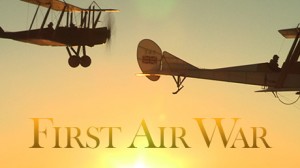
http://www.pbs.org/wgbh/nova/military/first-air-war.html
The airpower domain in its present construct lies in a controlled state where actions can be planned, modeled, and forecast with routine predictability.
This configuration, while a familiar and reliable process, has unfortunately led to atrophy in our quest to inject modern and innovative means into this domain.
In contrast, what we are witnessing in China is great enthusiasm for their space program as well as a drive to shape new and modern aerospace strategies.
The biggest challenge we may well face from China is our own lack of enthusiasm and a complacent assumption of superiority that was born from past achievement but not paid for in the achievements of the future.
From our perspective, cost has become a driving factor that puts the air domain well beyond the scientific realm and into the context of engineering.
Unfortunately, financial constraints have hampered the competitive spirit that brought us so much success in the past, and it has opened the door for competitive nation-states to overtake our capability and it positions them to best us in both domestic and global respects.
What does seem clear is that modern breakthroughs of the late 20th century featured fast transmission of information.
This led to concepts such as information as an asset and displays allowing great portability of decision making processes.
In military terms, this translates into situation awareness, and command and control.
This flattens hierarchies; and puts decision control closer to the point of application of weapons.
As this was largely an inspiration of American Ingenuity, it seems easy to forecast this infusion into Airpower in the coming decades.
This allows for connectivity much talked of, and seen between the ground, maritime, and air domains, throughout the beginning stages of this century.
Conceptualizing the Way Ahead for Airpower: Rethinking the OODA Loop
We have reached a point where we must assess the airpower domain, and this should be accomplished using an appropriate contextual approach.
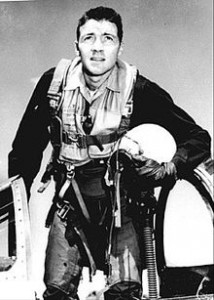
One approach that bears examination includes the underpinning of our armed forces’ raison d’être as cited in our constitutional preamble: “To Provide for the common defense” of the nation.
Utilizing this founding premise as a fundamental benchmark, we will assess whether we continue to appropriately fulfill this critical mission.
Globalization may have brought the world closer together in terms of collaboration, but the United States remains a singular continent that can now be reached by the forces of military globalization, missiles and nuclear weapons.
Without air superiority, we can neither defend our land nor project power abroad.
If we rest our assumptions of superiority on an aging stock of proud yet outdated airplanes, we can never hope to prevail in the face of rising and adventurist powers like China and other modern adversaries.
In this piece, I would like to examine a way forward in understanding how we can recapture air superiority and the enthusiasm necessary to build and sustain it.
I am going to champion the ideas of John Boyd that, while initially targeted towards individual pilot, can also serve as a tool to building overall force capability in the next twenty years.
Leveraging the OODA Loop
A significant component of our mission is to preserve America’s ability to act in its best interests and preserve national security.
In this context, let us look at the contribution of the airpower domain as a part of the larger Observe, Orient, Decide, Act (OODA) Loop- a concept first brought to our attention by military strategist Colonel John Boyd (“The Essence of Winning and Losing,”1996) when dissecting air combat. Boyd breaks this cycle into four interrelated and overlapping processes through which one cycles continuously:
- Observation: the collection of data by means of the senses
- Orientation: the analysis and synthesis of data to form one’s current mental perspective
- Decision: the determination of a course of action based on one’s current mental perspective
- Action: the physical playing out of decisions
In later years, Boyd expanded the OODA Loop concept and applied it to other forms of competition in society.
This included multiple sensor functions that deliver data or convert it into amplifying information.
Further, the Loop was applied in academic circles as it examined mental processes and allowed for a different approach to cultural, genetic and other inputs that arrive in later stages of the orientation period.
According to Boyd, decision points and sound courses of action are achieved by converting a wealth of information into useful, actionable data.
This provides a person with sufficient command and control relative to a situation, and ultimately this guidance allows for the successful carrying out of one’s objective within the OODA Loop construct.
This procedural overview provides some intellectual backdrop as we take a good look at airpower in the 21st century, and as this discussion has already argued, shaping a force that leverages the OODA Loop is a key strategy in the way ahead.
Strategic Dominance
Another element that bears examination is determining whether the Air Force has remained on the strategic path fostered by the Mighty 8th in the Second World War, and also espoused by General Curtis Lemay.
Are we committed to strategic dominance in airpower, or are we just willing to have a checkmate with our adversaries and potential adversaries?
With the end of the air battle in Europe, the Army Air Corps and the services certainly understood that without air superiority and dominance, the Nazis would have been difficult to dislodge- let alone to defeat.
But what about today’s Air Force?
Does it adopt a “just enough” approach in supporting the coalition of the willing-but-unable, or does it continue to serve as the strategic backbone for deterrence and global warfighting?
Combining this optic of strategic dominance with a macro look at the OODA Loop, how does our current approach stack up?
The Air Force Vision for 2013 was released just as the new Chief of Staff was feeling the harsh realities of a constrained fiscal environment.
With such restrictions in mind, his vision would ultimately be considered an aspirational perspective, in spite of the ideas communicated by the Commander.
Still, his guidance could not be wholly disregarded, as it remained instructive in measuring his strategic ideas against the intellectual foundation of the OODA Loop.
A look at excepts of the Vision Statement will provide a better understanding:
“The world’s greatest Air Force – powered by Airmen, fueled by innovation
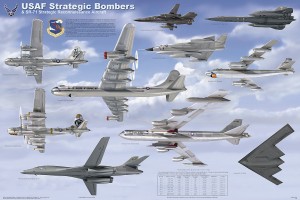
The Air Force’s enduring contributions are rooted in our original roles and responsibilities that were assigned in 1947.
Today we call them:
(1) air and space superiority;
(2) intelligence, surveillance, and reconnaissance;
(3) rapid global mobility;
(4) global strike; and
(5) command and control.
We already combine our air, space, and cyber forces to maximize these enduring contributions, but the way we execute these five calling cards must continually evolve as we strive to increase our asymmetric advantage.
“To strengthen our enduring contributions, the Air Force will:
• Deter and defeat adversaries with a credible first look, first shot, and first kill capability;
• Hold our adversaries and what they value at risk while operating on a global scale with unmatched joint integration;
• Exploit and defend air, space, and cyberspace, especially in contested environments, while denying our adversaries unrestricted use of the same;
• Integrate and organize our Active, Reserve, and Guard forces to leverage the unique strengths and perspectives of each to seamlessly execute Air Force missions;
• Enhance relationships and interoperability with our sister Services, other government agencies, allies, and partners;
• Better train Airmen to bring their unique specialties together in more realistic, intense, and diverse environments to advance integrated airpower operations;
• Emphasize readiness to ensure the highest quality force, regardless of size;
• Modernize our capabilities to reduce operating costs while attaining desired effects with greater persistence, survivability, longer range, and more versatile payloads.”
While this language provides more of a forward looking and futuristic perspective, it is also important to consider the past if we are to gain some grounding in moving forward.
An example of this involves the modern day dilemma of incorporating the cyber mission into The Mission of the Air Force.
At present neither the Air Force nor the nation possess superior capability within this discipline, however it should be remembered that Air and Space missions once undergone similar struggles while in their formative years.
In this regard, it is important to not only look forward, but also rely on lessons learned of past initiatives.
The OODA Loop As A Measuring Stick
Casting the new Air Force Vision against the underpinnings of the OODA Loop is a revealing and worthwhile effort.
In this section, each step in the Loop cycle will be applied to our modern concerns with reinforcing airpower.
Observe
Strategically, intelligence, surveillance, and reconnaissance (ISR) activities fits nicely into the Observe element, as does the emphasis on Space operations.
This is all about gaining access to information that might otherwise be denied, but there is also an emphasis on enhancing relationships and interoperability with our ‘go to war’ partners.
In this modern era of social media, this reach must now extend to areas undergoing current analysis- to include the Observable Data that is captured by all of the flying or orbiting sensors that the ‘go to war’ partners currently provide.
This is element is one that our intelligence services currently grapple with, and it goes hand in hand with managing the impressive flow of observable data that is shared all around the globe each day.
With the acceleration of modern technology and the capability to collect increased amount of data, it is incumbent upon the Air Force to recognize that significance of this influx of data.
An increased awareness across the service will facilitate the possibility that information sharing will be achieved between its forces and allied or sister service sensors.
For the moment, let us presume that the groundwork exists to increase the flow of data and apply advanced analytics to enable awareness of all available observable facts.
Let us also presume that these data points can be converted into actionable information that is readily available to commanders and planners.
In achieving this, we can fulfill the requirements of step one of the OODA Loop by fully addressing the Observe function.
For the purposes of the Air Force, this must mean that an investment stream is effected that can extract maximum knowledge from all information culled ‘see deep’ radars- whether they are on airborne, maritime, or space platforms.
With such an abundance of tactical data, the critical question becomes, ”Where do all of the captured observations go, and how will they contribute to the next step in the OODA Loop with respect to achieving airpower?”
Orient
Looking at the Orient part of the OODA Loop, the Air Force Vision emphasizes readiness and training in two major areas: training for airpower exercises (which points to the exploration of capabilities), and limits or surprise elements that may be available to the engaged forces.
Such readiness and training in the form of joint and partner exercises will add to the critical leverage and agility in this step of the planning cycle.
Admittedly, training the decision makers in force capability can be a tricky element.
Most have grown up inculcated by only their service orientation, and any shared knowledge for sister service capabilities is only superficial because it is brought to the table from outside of a particular service’s native environment.
It takes engagement in joint exercises before one can truly begin to understand how unfamiliar systems can boost operations during an engagement.
It is this element of synchronizing our resources that is explored in the concept of operations, and it underscores the importance of recognizing alternatives that can fill a gap in capability.
This concept must be resident in the mind of a commander if he or she wishes to seek and successfully solicit methods capability of achieving his objective.
Concepts for joint effect such as The Long Reach of AEGIS (published in the U.S. Navy publication Proceedings) aptly demonstrate this compounding effect of application of our modern systems.
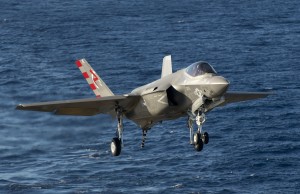
It is this synthesis of data that serves as the benchmark of the Orient portion of the OODA Loop.
Situation awareness can now be shared among combatant units from ground and maritime units with their air elements and with strategic air elements to both deter or destroy aggressors, and so in real time Command Authority intent can be rapidly translated to action and effect.
At its most basic essence, orientation really drives at the nature of readiness.
In the modern warfare environment, warfighters cannot be effective if they only possess an understanding of the capabilities of their own platforms.
In order to fully understand the synergy and extension available through the interaction of the various offered platforms, they must be smart on assets available from the ‘Go To War’ partners.
Further, data flow in the modern day has become far more automated as transmissions occur from machine to machine and no longer requires a question and response trigger in order to facilitate communication exchange.
This automation impacts the Orient step at an individual level as the lone Battle Manager must ensure a “human” and therefore logically sound synthesis of information is achieved.
This step away from automation at the ground level is critical as assessments and judgments are often fed directly to strategic decision makers and perhaps even the National Command Authority.
The discussion on Orientation could extend, as it does during wargames, from the diplomatic level to the time-sensitive and wartime scenarios of competitor reactions and tactics.
It is important, therefore, that we not limit ourselves to only the decisions executed by higher-level strategists and decision makers.
As previously mentioned, Colonel Boyd developed his theories by examining ‘dogfights’ between two competent fighter pilots.
In the modern day, it is a rarity to witness this ‘mano a mano’ conflict, and for the focus has shifted to training towards a ‘many on many’ premise, ideally with leverage from numerous available systems and support platforms.
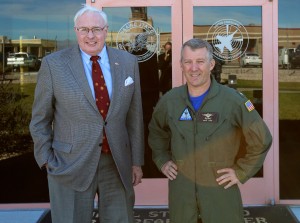
It is a far more difficult and complex problem to match our force against the evolving combat environment, and the capability to conduct dogfights has been replaced by the need to influence events in a 360 degree operational space.
Today there are far more systems working to deny us the capability to maintain airpower superiority.
Interestingly; our army and naval commanders are already familiar with the depth and breadth of synthesized planning as they participate in fleet and theater operations in a joint environment.
In the past many of these same strategies have been applied as air armada operations reprising World War II tactics have been utilized.
These pre-strike sorties have enable understanding of enemy strengths and weaknesses, in addition to accurate targeting data and localization of anti-access systems.
Dynamically, the use of fifth generation aircraft as target location systems may not be seen as satisfying to the traditionally trained pilots, but it can serve a vital role for forward observers in concealed locations.
If executed fluidly, the flow of information on targets can be near real time so that the data is oriented and proved useful to commanders in pressing a plan.
In sum, the 360-degree revolution and the ground-to air revolution that is already witnessed with the remotely operated visual enhanced receiver (more commonly known as ROVER) provide a key perspective to shaping the future of airpower, as well as a view of airpower beyond what the USAF traditionally considers its operating domain.
Decision

https://sldinfo.com/wp-content/uploads/2013/08/B-17-Returns-to-France.pdf
We now arrive at the decision point and its associated methodology.
The Vision statement describes command and control systems as a paramount operating commitment to the Air Force.
The operation of this resilient system could very likely be under assault during the run up to an engagement, as the world saw during the run up to the invasion of Georgia by the Russian forces and the run up to diplomatic negotiations with Estonia.
Our peer competitors got to practice with real time integration of cyber and physical forces, and this has been accomplished in joint exercises ever since.
Whether it is a day without space, or communication under duress, it is all a part of the Decide point in the OODA Loop.
To put it in more concrete terms, when one sends two B-2s or two F-22s to the North Korean deterrent fight, what options does the national command authority really have if their bluff is called?
As the Air Force considers itself to be a part of the run up and flow down Decision points, it is incumbent on the Air Force to ensure the integrity of the data flow in both directions.
By extension, there then exists a sharing of this integrity amongst the various agencies that serve as information providers and decision executors.
The Air Force mission to be in Cyber is all about an awareness of this responsibility and the impact of trusted data to its forces, and this will only grow in importance over time.
Action
The final element in the OODA Loop is Action.
We have seen the Air Force’s role in the Observe, Orient, and Decide elements, but it is in the Action portion that the essence of military force resides.
Sir Winston Churchill has best described our state of affairs as, “The power of an air force is terrific when there is nothing to oppose it.”
This has been the state of play in the engagements for the past quarter century, and this has misled key decision makers to consider investment in the air domain as a waste.
Decision makers failed to look to forward and anticipate a future with peer competitors, and instead they decided that sitting on their lead was sufficient in the name of saving resources.
Secretary Robert Gates once said in a speech to the Economic Club in Chicago:
Consider that by 2020, the United States is projected to have nearly 2,500 manned combat aircraft of all kinds.
Of those, nearly 1,100 will be the most advanced fifth generation F-35s and F-22s. China, by contrast, is projected to have no fifth generation aircraft by 2020.
And by 2025, the gap only widens.
The U.S. will have approximately 1,700 of the most advanced fifth generation fighters versus a handful of comparable aircraft for the Chinese.
Nonetheless, some portray this scenario as a dire threat to America’s national security.
This projection, although seemingly ominous, turned out to be false in two respects.
First, Chinese and Russian fifth generation fighters were indeed manufactured, and domestic cutbacks started almost immediately prior to the F-35 program.
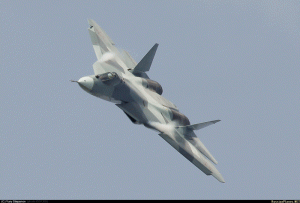
The potential of a threat to America’s security was certainly not yet dire; but one cannot help but wonder if these developments have signaled a drift in priorities.
As General George Kenney was said, “Airpower is like poker. A second-best hand is like none at all — it will cost you dough and win you nothing.”
Even Secretary Donley, who while Secretary Gates was in the position wrote a letter supporting Gates’ decision to stop producing F-22’s has now testified that ” The Air Force has stretched the risk we can prudently take and must push now to get the most combat power possible from our forces.”
Strategically, “action” is where most armed forces dwell and operate most effectively.
This is also the beauty of the OODA Loop, as it transcends levels of scope and allows each stage to explore uses of the components of its forces.
At the same time, this devolvement may result in independent behavior and what has become ‘islands of excellence’ or ‘stovepipes’.
One of the best examples of this involves the use of geography to establish operational division between ground units.
In Iraq 2003 for example, the Euphrates River was used by commanders to separate successful campaigns by the Coalition Army and Marine forces.
Each supported one other by protecting the common flank, which was the river itself.
This effort became muddled as progress reports became discordant, and command authorities began to order slow downs and halts- a move that was strikingly similar to Eisenhower’s commands of British and American forces in the Second World War.
For these reasons and more yet; it is heartening to see the Air Force Vision statement utilizing terms like integrate, and interoperability, and building relationships.
Actions taken in the rapid fire future engagement will need nearly machine to machine coordination as the weaponry flies farther; and with more devastating effect, and mastering these concepts of integration, interoperability and relationship building will become crucial stepping stones.
Additionally, with our forces diminished by obsolescence and budgetary drawdowns; we must believe our ‘first look, first shot, first kill’ slogan so as not to waste precious commodities of the future fight that include projectiles, missiles, bullets and cruise missiles.
Credible feedback as the battle progresses may be a difficult commodity, but it is incumbent on the Observe element to continue to provide situation awareness to every level of command.
We must fully integrate the force so that every shooter is a sensor, and some sensors as shooters can provide facts about targets and anti-access platforms that will minimize our own casualties.
The Need for an Attack and Defense Enterprise
In this element of the OODA loop is where the offensive enterprise resides.
This enterprise is composed of all the elements for expeditionary warfare, to include resupply.
The Air Force, in designing its force structure, also serves as the supply element for other services in rapid mobility exercises.
As an example, the tanker force does not only function as a self-servicing agent, but also as an asset for joint and coalition forces.
In the same vein, in this time of reduced resources, the Air Force must look to coalition partners as it has in the past to provide needed firepower and support elements that go beyond airfield support.
When Admiral Mike Mullen was alluded to building a “thousand ship Navy,” he envisioned that our coalition partners would be included in our own force element.
Similarly, the Air Force must also count the tankers, C-17s, as well as the complementary fighter elements that may be made available to counter competitor actions. It has become increasingly clear that our governing body will not be able to provide a complete complement of ready forces as we formerly were accustomed.
How this risk is characterized should be left to the word of the active military commanders, but it has been clear that in future operations, a reliance on coalition equipment is paramount.
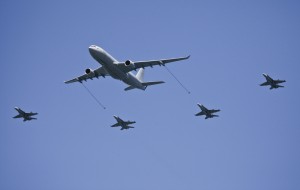
By 2025, the Air Force should size its offensive capability around the fifth generation force construct. The fourth generation aircraft should be dominantly assigned to the defensive enterprise, chiefly protecting the Homeland and some expeditionary locations.
The vulnerability of large command and control aircraft is well known, but America continues to believe that we will own the skies in the future fight.
This is an unsustainable prediction.
Our aircraft may retain utility as requirements develop and evolve, but one wonders about the allocation of resources between assured victory and the aftermath.
This is the decision that must underscore the future of airpower.
As one fighter pilot put it when asked about the results of ‘Cope India’ in early 2007, “Thank goodness we competed with degraded capability, because when the competitor discovers they can kick your ass;, they won’t stop at their border or yours.” Should this occur, thing will be sure to get ugly.
In the case of Space, Cyber and Transportation, funding should not be spared with respect to training and support of the offensive enterprise with respect to national objective support.
Unfortunately, when funding constraints start to where they are trained and support the offensive enterprise or can be shown to become a reality, objectives can become obscured.
Our dominance in Space currently rests in quantity, and this should not be confused with military dominance other than when it is used in support of military operations.
We have not had a conflict involving space assets, but we have seen other nations training to conduct such conflict. The rules for such a conflict are not yet clear, and thus research into resiliency such as fractionated satellites or other survivable mechanics have not been invested.
During this interwar period, such an invention might well turn future tides in battle.
With our forces growing more and more reliant on space capabilities, a ten-year target for truly resilient space should be developed.
Cyber has already seen application in war as demonstrated during the campaign in Georgia.
In this case the national ability to connect was denied in parallel with aggressor action that crossed the border.
Such denial resulted in a successful invasion that persists to this day with hostile troops occupying a part of that nation.
The current cyber war is more economic than military, but it is also so clandestine that attacks and aggressive defense have been masked in the related activity.
There will need to be research on how to ultimately defend or cover our intended activities.
The current concept of mutual assured destruction as adapted to each domain is currently in vogue, but the extension into cyber belies the low barrier to entry, and makes it mandatory to put in place true barriers. That said, tailoring for each service application will continue to dominate current investment.
Nothing has happened to detract from making Cyber more and more intrinsic into operations and administration, and war logistic and humanitarian activities- especially as commercial applications- become increasingly adaptable.
Adaptability and agility will dominate this domain, thus impacting command and control activities. Investment in training and integration with other force elements will therefore become critical.
Re-Shaping the Technological Advantage
One of the first uses for the OODA Loop was to foster energy maneuverability in fighter design.
This application of physics was at first left to the winners of engagements during World War I and World War II; but Colonel Boyd used it to advocate for the design of the lightweight fighter that became the F-16.
In a famous photo comparison; his theory was played out illustrating the turning radius of the F-4 and the F-16, where it was clear that the F-16 could start out as the hunted and end up quickly as the hunter.
From this illustration, well over 7,000 aircraft have been produced for use by air forces all over the world, and many more for configurations of missiles.
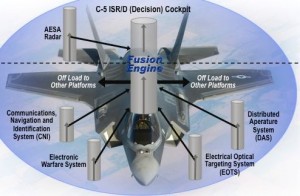
This use of the OODA Loop has clearly resulted in fewer one on one fights, and a greater concentration on force to force operational concepts. ‘First look, first shot’ is the war cry today and not ‘Give them the gun’.
During this same period, concepts for anti-access; and counter anti-access became design elements, and conceptions for 5th Generation Fighters came about via the F-117, B-2, F-22, and F-35.
It is safe to say that the ferocity of the anti-access forces appearing in a less than peer competitor during the Vietnam War was a strategic surprise, and it was countered by technological advance and investment.
It is clear that the “Action” part of the OODA loop is highly dependent on whether this technological advance is followed through to a real force advantage.
All of the elements of our current Air Force- whether Space, Cyber, Transport, and our magnificent Airmen who provide at a moments notice- work at a deliberate pace in responding to the national command authority decision to act.
My own doctrine ” If you are ever involved in a fair fight; it is the result of poor planning.” emphasizes proper action throughout the OODA loop; and entails actions by resource decision makers and department leadership to maintain our strength and resilience in periods of high activity and periods of pause.
Even with the chastisement of Secretary Gates for his prognostication, the words of a former Russian diplomat ring in my mind:
“The future is not understandable, and we do not entertain predictions.”
There must be planning that reasonably reflects the desires for maintaining our national sovereignty, and the opportunity to contribute to lasting peace through strength can be achieved by implementing the OODA Loop.
Conclusion
Airpower in the 21st Century will be all about maintaining a sufficient deterrent capability to preserve the always-fragile peace.
Airpower provides leverage to our diplomats and it provides credibility to our joint operations.
We spent the better part of the 20th Century identifying and developing the lead technology of stealth and we embedded it into our fifth generation of fighters and bombers.
This progress must be maintained.
The fusion of information transmission between the land, Maritime, and Air Combat components must be a near term goal to leverage every aspect of our forces engaged.

This accelerates the OODA loop by insisting that every shooter be a sensor; and some sensors as shooters as well.
Transmission of information will strain our capabilities, and stress the security element; but with the pace that all discuss in future war; keeping the command authorities abreast of the action will serve all well.
There will be fewer resources available for our military as our assets dwindle and the capability to leverage forces from engaged partners emerge as the key to victory in the future fight.
The recognition by our international partners is clear evidence that this investment was in the right direction, and this investment must continue.
To close; let it be said by our past leaders:
If our air forces are never used, they have achieved their finest goal.
— General Nathan F. Twining
If we maintain our faith in God, love of freedom, and superior global airpower, the future [of the US] looks good.
— General Curtis Lemay
This is the mission and goal of airpower in the 21st Century.
Editor’s Note: This article by Secretary Wynne is part of our look at the evolving airpower dynamic, notably with regard to shaping an attack and defense enterprise.
We have benefited from the insights of current airpower leaders in shaping such an enterprise:
https://sldinfo.com/thinking-airpower-leaders-and-preparing-the-way-for-the-f-35/
https://sldinfo.com/the-pacaf-commander-and-reworking-pacific-defense-the-aor-will-become-a-caoc/
And we have a forthcoming interview with the current head of Naval Air Warfare Admiral Manazir, which provides an overall perspective on the reshaping of Naval airpower with regard to the dynamics discussed by Secretary Wynne.
And from the core team of Second Line of Defense we have contributions of our own:
Lt. General (retired) Deptula has focused on the empowering of the air combat cloud as a key element of the attack and defense enterprise:
https://sldinfo.com/the-next-phase-of-air-power-crafting-and-enabling-the-aerospace-combat-cloud/
Ed Timperlake will publish soon a piece looking at the evolution of Tron Warfare and how the fifth generation fleet adds new tools to the toolbox to empower the attack and defense enterprise.
(For an earlier piece along these lines:
Of course, Mike Wynne has provided and continues to provide an important leadership role with regard to shaping thinking about the future of airpower.
Recently, the former Chief Scientist of the USAF, Dr. Mark Lewis, visited the Astronautics Department at the USAF Academy and found this recognition of Secretary Wynne’s accomplishments:
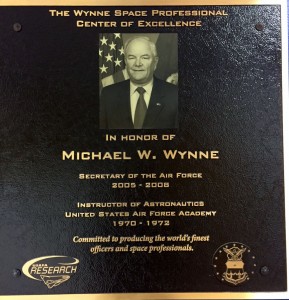
Indeed we have built a series, which looks back at his time in government and industry highlighting past engagements:
https://sldinfo.com/acquisition-innovation-in-the-department-of-defense-breaking-the-logjam/
https://sldinfo.com/the-wynne-legacy-generating-and-diffusing-innovation/
https://sldinfo.com/michael-w-wynne-i-hate-logistics/
https://sldinfo.com/innovation-inside-the-bureaucracy/
https://sldinfo.com/innovation-in-the-usaf-a-look-back-by-dr-mark-lewis/
For a PDF of this article see below:
Airpower in the Next Two Decades of the 21st Century
And an example of learning going forward by looking back is the path and impact of the B-17 on World War II:


